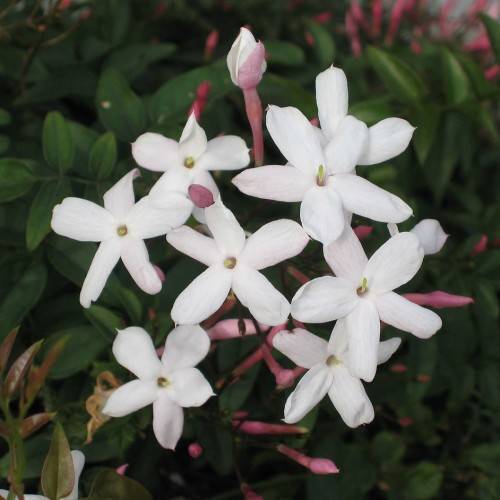
jasmine
Jasminum polyanthum
Cycle:
Perennial
Watering:
Frequent
Hardiness Zone:
8
Flowers:
Flowers In Summer
Sun:
Full sun, Part sun/part shade
Soil:
Bog
Fruits:
Fruits Ready In Summer
Leaf:
Yes
Growth Rate:
Moderate
Maintenance:
Low
Drought Tolerant:
Yes
Salt Tolerant:
Yes
Care Level:
Medium
watering
Fiber optic grass (Isolepis cernua) prefers moist soils, so it should be watered regularly. It should be watered lightly but consistently, giving 1-2 inches of water per week, either from rain or irrigation. Watering too lightly or too infrequently can cause the grass to suffer from drought. On hot dry days, water more frequently. Avoid overwatering, however, as too much water can lead to root rot or fungal diseases. For best results, water consistently and thoroughly to keep the soil moist but not soggy.
sunlight
Fiber Optic Grass (Isolepis cernua) is a fast-growing, low-maintenance plant that can be grown in full sun to partial shade. When growing fiber optic grass, it should receive a minimum of 4 to 6 hours of direct sunlight per day. This can be provided in the late morning or early afternoon when the sun is at its brightest. Avoid planting in full shade, as this will cause the grass to become leggy and weak. To promote healthy growth, make sure the soil drains well and the plants are watered regularly.
pruning
Fiber Optic Grass (Isolepis cernua) should be pruned in late fall or early winter. When pruning this type of grass, you should remove 1-third of the plant's foliage. Additionally, you should remove any damaged or dead foliage before pruning. Doing so will ensure that the plant retains its shape and vigor. After pruning, make sure to spread a thin layer of compost around the roots to help the plant recover from its trim. Pruning Fiber Optic Grass can extend its life and keep it looking its best.
Season
Hardiness Map
FAQ
Is Jasmine’s fragrant good?
Jasmine's fragrant is very good. It has a sweet, floral scent that is pleasant and calming. It has a strong hold that lingers for a long time without becoming too overpowering. Jasmine's fragrant has been described as calming, peaceful, and refreshing. It is especially nice in aromatherapy products and as a personal fragrance. Those who display it in their home often find it to be a pleasant complement to their environment.
Is the Jasmine plant being common houseplant?
Yes, the Jasmine plant is commonly found as a houseplant. This flowering houseplant is known for its fragrant flowers, and since it is easy to grow and maintain it is a favorite of many home gardeners. The semi-woody vine can be easily grown indoors in containers and has become a popular choice for home decorating. Jasmine plants prefer well-drained soil and temperate, light conditions. When the plant blooms, it releases a powerful and pleasant aroma that fills the air around it.
Are jasmine easy to grow?
Yes, jasmine is an easy to grow plant. It is easy to maintain, requiring little in terms of water, fertilizer and pruning. All jasmine varieties prefer sunny spots with some afternoon shade for best results, and plenty of light for flowering. Planted in well-drained soil and in a climate with mild winters, jasmine can also thrive in container gardens and indoors as a houseplant.
Could jasmine flowers use for decorative purposes?
Jasmine flowers can absolutely be used for decorative purposes! Not only do these flowers produce an incredibly pleasant and sweet fragrance, but they are also incredibly beautiful and elegant. Jasmine flowers can be used to create stunning bouquets and centerpieces, as well as to create a lovely look around the perimeter of a house or garden. They also make lovely additions to wedding decorations and banquets, or can be used to top a cake or other dessert. Jasmine flowers are a great option to use for any kind of decorative purpose!
Do jasmine plants attract pets?
Yes, jasmine plants can attract pets. The fragrant scent that the flowers produce can be a source of fascination and curiosity, prompting cats, dogs, and other animals to investigate. If a pet is particularly sensitive to tastes or smells, they may find the scent of a jasmine plant to be inviting and seek to explore it further. It’s important to keep in mind, however, that not all jasmine plants are safe for pets and that some are actually toxic if ingested.
Do seasons affect the thriving of jasmine plant?
Yes, seasons can affect the thriving of jasmine plants. In mild climates, jasmine plants can grow year-round, but in colder climates they may die back during the winter months. Depending on the variety, some jasmine plants may even go dormant during the wintertime when temperatures drop. During spring and summer months, jasmine plants need regular watering and plenty of sunlight to thrive. They may also benefit from some trimming of the branches and stems during late winter for best growth.
Can Jasmine plants grow by cutting?
Yes, Jasmine plants can grow by cutting. To propagate these plants, you can take terminal cuttings from an actively growing stem during spring. Trim the stem to about 6 inches in length and remove any flowers, buds and leaves from the lower half of the stem. Place the cutting in a pot or soil-filled tray with the lower portion of the stem buried and lightly water it. Cover the pot or tray with a plastic bag and keep it in a warm and lightly-lit spot. If all the conditions are right, the cutting should produce roots within a few weeks and eventually a new Jasmine plant will form.
Is jasmine native to any particular region?
Jasmine is actually native to tropical and warm temperate regions of both the Old World (India, Southwest Asia, etc.) and the New World (Central and South America). Jasmine is most commonly found in the Himalayas and is also found in tropical parts of Africa. Jasmine plants prefer areas that are warm and humid and tolerate a limited amount of drought.
